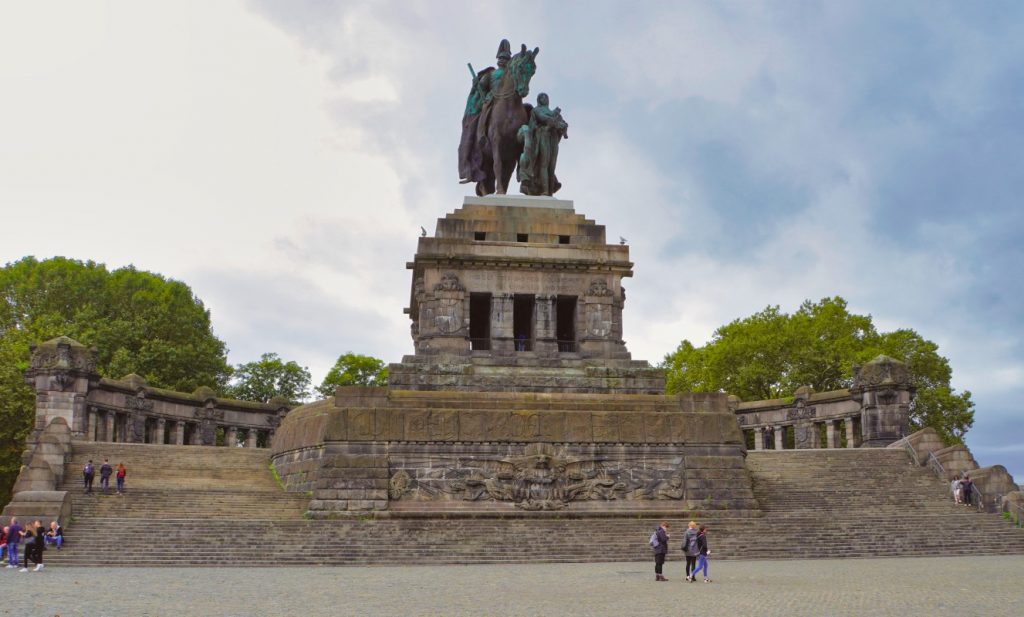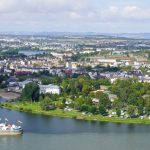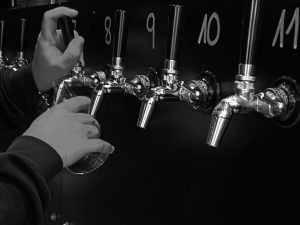Koblenz is where the Moselle flows into the Rhine. Here is one of the most visited places in the city, the German Corner in Koblenz with the monumental equestrian statue of the German Emperor Wilhelm I.
Who would have known…
In 1216, the then Archbishop Theoderich von Wied called the Knights of the Teutonic Order to Koblenz. He gave them, presumably with the ulterior motive of securing local health care through the knights, part of the grounds of the Kastorkirche with the attached hospital. The Order built a manor house and the area was then called “Deutscher Ordt”, later “Deutsches Eck”.

Today, a faded cross on a house wall commemorates the Knights of the Teutonic Order and symbolizes the actual German Corner.
The “new” German Corner is being built
In the 19th century, the site of the confluence of the Moselle and Rhine began to be redesigned. A harbor of refuge was created with a breakwater and an offshore sandbank to provide protection for the mariners.
After the death of Emperor Wilhelm I in 1888, various bodies planned to erect a monument in his honor. Kaiser Wilhelm II chose Koblenz and the site at the confluence of the Rhine and Moselle from among numerous applicants. Funds were raised, the emergency harbor was filled in, and in August 1897 the monument was dedicated in the presence of Kaiser Wilhelm II.

In the vernacular, the German Corner in Koblenz now shifted from the actual location, only a few meters away, to the site with the huge statue.
Equestrian statue: Emperor Wilhelm Monument
The entire monument is 37 meters high. Only the equestrian statue alone has the considerable height of 14 meters.
Depicted is Emperor Wilhelm I sitting on a horse in a general’s uniform with flowing coat. A female genius (guardian spirit/guardian angel) with wings accompanies the emperor and wears a laurel wreath and the imperial crown.

Standing in front of the monument, one can discover not only the large lettering William the Great, but also an imperial eagle grasping snakes and harassing enemies. In the upper part of the pedestal is written “Nimmer wird das Reich zerstöret,/ Wenn ihr einig seid und treu!” These are verses from a poem by the Koblenz poet Max von Schenkendorf.
Although the air raids during World War II destroyed the city center of Koblenz, the German Corner remained almost undamaged. It was only shortly before the end of the war that an artillery bombardment destroyed the equestrian statue. It hung down deformed and torn, and so it did not take long for the copper to gradually disappear. Finally, the remains were dismantled and melted down. The emperor’s head later reappeared and can be seen today in the Middle Rhine Museum in Koblenz.
The now empty pedestal remained standing and in 1953 was transformed into the “Memorial of German Unity” by the then Federal President Heuss. The coats of arms of all German states and the former eastern territories were affixed to the pedestal and a flagpole with the federal flag was placed in place of the equestrian statue.

In 1987, the then publisher of a newspaper, Werner Theisen, decided to finance the reconstruction of the statue and donate it to the city of Koblenz. Although the state of Rhineland-Palatinate, as the owner of the land, rejected the donation, he commissioned a metalworker to produce the statue in 1989. It was a political struggle that was only resolved when the city of Koblenz received the land as a gift from the state and now assumed responsibility. The monument had already arrived in Koblenz and now the pedestal had to be restored as quickly as possible. On 2.9.1993, the emperor could once again take his place at the Deutsches Eck.

Today, the Kaiser Wilhelm Monument is part of the UNESCO World Heritage Upper Middle Rhine Valley.
Visit to the German Corner in Koblenz
It is a short walk from the city center to the Deutsches Eck (German Corner), which is like a point at the confluence of the Rhine and Moselle rivers.

Standing here and looking down on the two rivers is really beautiful. The view of Ehrenbreitstein Fortress, with the cable car going up there, makes you want to discover more.

The equestrian statue is imposing and a great photo motif. Every now and then you see someone climbing up the pedestal, only then you realize how big the whole complex is. The living person next to the statue looks a bit like an ant.
If you walk around the monument you will surely discover the “original” German Corner.
Address:
Konrad-Adenauer-Ufer,
56068 Koblenz
The visit to the German Corner was part of a blogger trip . The post was created independently of the visit.









Leave a Reply